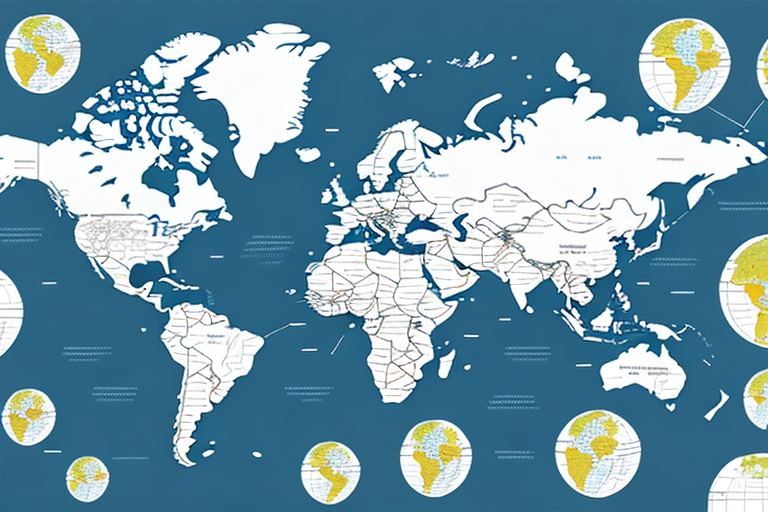Comparing International Shipping Package Rates for UPS
Shipping packages internationally can be a costly and time-consuming process. When it comes to international shipping, one of the most popular carriers is UPS. However, with so many variables to consider, it can be difficult to determine the best shipping option for your needs. In this article, we will explore the importance of comparing shipping rates for international packages and how to get the best deal on UPS international shipping.
The Importance of Comparing Shipping Rates for International Packages
Shipping rates for international packages can vary greatly depending on the carrier, destination, package weight and size, and other factors. Comparing rates between different carriers can help you identify the best options for your budget and time constraints. By taking the time to compare rates, you can avoid overspending on shipping costs and save money on your international package shipments.
- Cost Efficiency: Identifying the most affordable shipping options.
- Service Levels: Choosing between different levels of service based on delivery times and reliability.
- Additional Fees: Understanding potential extra costs such as customs clearance or signature confirmations.
- Restrictions: Being aware of any limitations or special handling requirements for certain package types.
It's also important to consider the level of service provided by each carrier when comparing shipping rates. Some carriers may offer faster delivery times or more reliable tracking information, which can be crucial for time-sensitive or high-value shipments. Additionally, certain carriers may have restrictions or additional fees for specific types of packages or destinations, so it's important to read the fine print and understand all the details before making a decision.
Understanding UPS International Shipping Rates
UPS offers a variety of international shipping services, including UPS Worldwide Express, UPS Worldwide Expedited, and UPS Standard. Each service offers unique features and pricing levels based on the destination, delivery time frame, and package weight and size.
UPS uses a zone-based system to determine shipping rates for international packages. These zones are based on the distance between the origin and destination countries, as well as the package weight and size. The higher the zone number, the longer the expected delivery time and the higher the shipping cost. UPS also charges additional fees for certain services, such as customs clearance or signature confirmation.
It is important to note that UPS offers a variety of tools and resources to help customers estimate shipping costs and track their packages. The UPS website features a shipping calculator that allows customers to input package details and receive an estimated shipping cost. Additionally, customers can track their packages in real-time using the UPS tracking tool.
When shipping internationally with UPS, it is also important to be aware of any restrictions or regulations that may apply to your package. Certain items, such as hazardous materials or perishable goods, may require special handling or documentation. It is recommended to review UPS's international shipping guidelines and consult with a UPS representative if you have any questions or concerns.
Factors Affecting UPS International Shipping Rates
Several factors can affect the rate you pay for UPS international shipping. These include:
- Package Weight and Size: Heavier and larger packages typically incur higher shipping costs.
- Destination Country: Shipping to remote or less accessible countries may be more expensive.
- Delivery Timeframe: Faster delivery options usually come at a premium price.
- Additional Services: Services such as insurance, signature confirmation, and customs brokerage can add to the overall cost.
- Type of Goods: Shipping hazardous materials or items requiring special handling may involve extra fees.
Another factor that can affect UPS international shipping rates is the type of goods being shipped. Some items may be subject to additional fees or restrictions, such as hazardous materials or items that require special handling. It's important to check with UPS or the destination country's customs regulations to ensure that your shipment complies with all necessary requirements.
How to Get the Best Deal on UPS International Shipping
To get the best deal on UPS international shipping, consider the following strategies:
- Compare UPS Services: Evaluate different UPS services to find the best balance between price and delivery time.
- Look for Promotions or Discounts: Take advantage of any available promotions or discounts for specific shipping routes or package sizes.
- Consolidate Shipments: Combine multiple packages into a single shipment to reduce overall shipping costs.
- Use UPS Online Tools: Utilize UPS's online tools to estimate shipping costs and compare rates based on package details.
- Proper Packaging: Ensure your items are well-packaged to prevent damage during transit, avoiding additional fees for damaged goods.
Tips for Comparing UPS International Shipping Rates
When comparing rates for UPS international shipping, consider the following tips:
- Check for Additional Fees: Look for any extra charges such as customs clearance, fuel surcharges, or handling fees.
- Compare Similar Services: Ensure you are comparing equivalent services between UPS and other carriers for an accurate comparison.
- Evaluate Delivery Time: Assess the delivery times offered by each service to meet your shipment's urgency.
- Understand Customs Regulations: Consider the destination country's customs regulations to anticipate any potential delays or additional requirements.
By taking these factors into account, you can make an informed decision when comparing UPS international shipping rates, ensuring that your package is delivered reliably and efficiently.
The Pros and Cons of Using UPS for International Shipping
There are both advantages and disadvantages to using UPS for international shipping:
Pros
- Variety of Shipping Options: UPS offers multiple services with varying delivery times to suit different needs.
- Reliable Tracking and Customer Support: Comprehensive tracking systems and responsive customer service enhance the shipping experience.
- Strong Global Network: Extensive international presence ensures widespread coverage and reliable delivery.
- Expertise with Hazardous Materials: Specialized training and equipment for the safe transport of dangerous goods.
- Customs Brokerage Services: Assistance with navigating complex international shipping regulations and paperwork.
Cons
- Higher Shipping Costs: UPS may be more expensive compared to other carriers, especially for certain routes.
- Additional Fees: Extra charges for services like customs clearance or signature confirmation can increase overall costs.
- Limited Coverage in Some Regions: While UPS has a strong global presence, there are areas with limited or no service coverage.
- Potential for Delays: Factors such as weather, customs inspections, or political unrest can disrupt delivery schedules.
Alternatives to UPS for International Shipping
If you are looking for alternative carriers for international shipping, consider the following options:
- FedEx: Offers a range of international shipping services similar to UPS, with competitive pricing and reliable delivery.
- DHL: Known for its extensive global network and efficient international freight services.
- United States Postal Service (USPS): A cost-effective option for smaller packages and shipments to certain countries, with partnerships that facilitate seamless international delivery.
- Freight Forwarders: Act as intermediaries between shippers and carriers, often negotiating better rates and handling logistics for large or bulky shipments.
- Regional Carriers: Smaller, regional carriers may offer competitive rates and more personalized service for specific areas.
How to Choose the Right Shipping Carrier for Your International Package
Choosing the right shipping carrier for your international package depends on several factors:
- Budget: Determine your shipping budget and compare carriers that offer services within your price range.
- Delivery Timeframe: Assess how quickly you need your package to arrive and choose a carrier that meets your timeline.
- Package Size and Weight: Select a carrier that can accommodate the size and weight of your shipment without excessive fees.
- Destination: Ensure the carrier has reliable service in the destination country.
- Reputation for Reliability and Customer Service: Choose carriers known for dependable delivery and responsive customer support.
- Additional Services: Consider any extra services you may need, such as customs clearance, insurance, or specialized handling.
Another important factor to consider is the level of tracking and visibility offered by the carrier. Some carriers provide more detailed tracking information, which can be crucial for high-value or time-sensitive packages. Additionally, consider potential language barriers or cultural differences that may impact the shipping process, and choose a carrier with experience in the specific region or country you are shipping to.
How to Save Money on UPS International Shipping
To save money on UPS international shipping, implement the following strategies:
- Consolidate Shipments: Combine multiple packages into a single shipment to reduce overall shipping costs.
- Seek Promotions and Discounts: Look for special offers or discounts available for specific shipping routes or package sizes.
- Compare Shipping Carriers: Explore rates from alternative shipping carriers to find the most cost-effective option.
- Use a Shipping Calculator: Estimate the cost of your shipment before sending it to identify the most economical shipping method.
- Opt for Lightweight Packaging: Use lightweight materials to reduce the weight of your shipment and lower shipping costs.
By implementing these strategies, you can save money on UPS international shipping and enhance your business's profitability.
Common Mistakes to Avoid When Comparing UPS International Shipping Rates
When comparing UPS international shipping rates, avoid the following common mistakes:
- Not Comparing Similar Services: Ensure you are comparing equivalent shipping services between UPS and other carriers for an accurate assessment.
- Overlooking Additional Fees: Be aware of extra charges such as customs clearance, fuel surcharges, or handling fees that can affect the total cost.
- Ignoring Package and Destination Requirements: Failing to account for the specific requirements of your package or destination can lead to unexpected expenses or delays.
- Focusing Solely on Cost: While finding the lowest rate is important, also consider the carrier's reliability, delivery times, and customer service quality.
- Assuming the Lowest Rate is Best: The cheapest option may not always provide the best value in terms of service quality and reliability.
Overall, comparing international shipping package rates for UPS can help you save money and find the best shipping option for your needs. By paying attention to the details and exploring multiple carriers and services, you can make an informed decision and ensure your package is delivered reliably and efficiently.
One important factor to consider when comparing UPS international shipping rates is the transit time. While UPS may offer competitive rates, their delivery times may not be as fast as other carriers. It's important to weigh the cost savings against the urgency of your shipment and choose a carrier that can meet your delivery timeline.
Another mistake to avoid is assuming that the lowest rate is always the best option. While cost is certainly an important factor, it's also important to consider the level of service and support provided by the carrier. Choosing a carrier with a strong track record of reliability and customer service can help ensure a smooth and stress-free shipping experience.




















